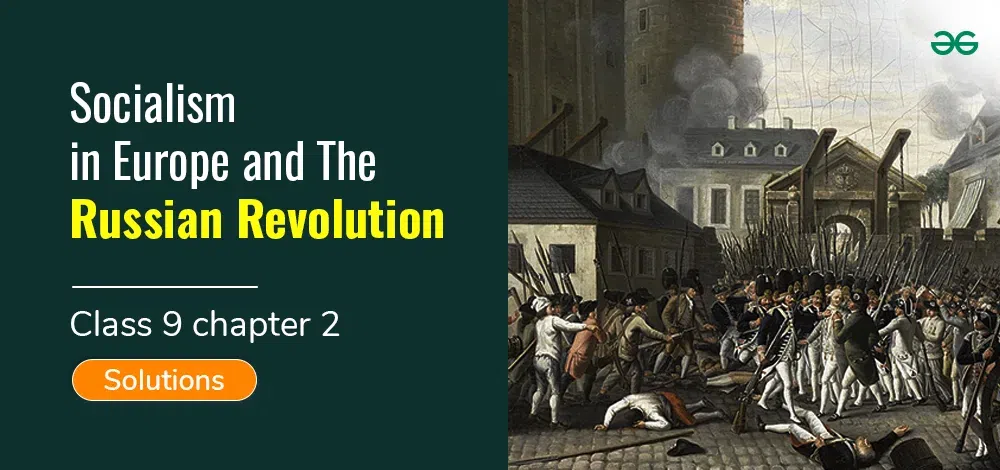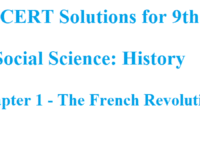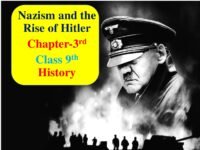🔹 1. Introduction
- Socialism emerged in Europe as a response to workers’ exploitation during the Industrial Revolution.
- Socialists wanted equality, fair wages, and social welfare.
- In Russia, economic hardship, political oppression, and influence of socialist thinkers led to the 1917 Revolution, which ended Tsarist rule.
Summary
Socialism arose in Europe due to the exploitation of workers during industrialization. Socialists demanded equality, fair wages, and welfare. In Russia, poor working conditions, low wages, and lack of political freedom caused unrest. Socialist thinkers inspired people to fight for change. The 1917 Russian Revolution overthrew the Tsar, established a communist government, and spread socialist ideas. It marked a major shift toward equality and social justice.
🔹 2. Industrialization and Its Impact
- Factories replaced traditional work; urbanization increased.
- Workers faced long hours, low wages, and unsafe conditions.
- Wealth concentrated among industrialists, while workers remained poor.
- Social inequality grew, leading to calls for reform.
🔹 3. Ideas of Socialism
- Socialists opposed capitalist exploitation.
- Promoted equality, collective ownership, and social welfare.
- Key thinkers: Karl Marx, Friedrich Engels.
- Marx wrote The Communist Manifesto, advocating workers’ revolution to establish a classless society.
🔹 4. Russian Revolution (1917)
- Causes:
- Poor living and working conditions.
- Harsh rule of Tsar Nicholas II.
- Losses in Russo-Japanese War and WWI.
- Influence of socialist ideas.
- Events:
- February 1917: Tsar abdicated → Provisional Government formed.
- October 1917: Bolsheviks led by Vladimir Lenin seized power.
- Civil War (1917–22): Red Army (Bolsheviks) vs White Army (opponents).
- Establishment of Soviet Union (1922).
- Impact:
- End of Tsarist autocracy.
- First socialist state in the world.
- Inspired movements for workers’ rights globally.
🔹 5. Key Terms
- Bourgeoisie: Wealthy factory owners.
- Proletariat: Industrial working class.
- Bolsheviks: Radical socialist group led by Lenin.
- Communism: Classless society with common ownership.
✅ Multiple Choice Questions (MCQs)
- What caused socialism to emerge in Europe?
a) Agricultural growth b) Industrial exploitation c) Monarchy d) War - Who wrote the Communist Manifesto?
a) Karl Marx b) Lenin c) Engels d) Rousseau - Which class worked in factories under harsh conditions?
a) Bourgeoisie b) Nobility c) Proletariat d) Clergy - Which Tsar ruled Russia before the revolution?
a) Nicholas I b) Nicholas II c) Alexander III d) Peter the Great - When did the Russian Revolution start?
a) 1905 b) 1914 c) 1917 d) 1922 - What happened in February 1917 in Russia?
a) Lenin took power b) Tsar abdicated c) Civil War ended d) Soviet Union formed - Who led the October 1917 revolution?
a) Karl Marx b) Nicholas II c) Vladimir Lenin d) Joseph Stalin - What was the Red Army?
a) Soldiers of Tsar b) Bolshevik military force c) Peasants’ group d) Provisional Government - When was the Soviet Union established?
a) 1917 b) 1918 c) 1922 d) 1930 - Socialism demanded:
a) Monarchy b) Private wealth concentration c) Workers’ equality d) Imperialism - What is proletariat?
a) Factory owners b) Workers c) Nobles d) Clergy - The October Revolution is also called:
a) February Revolution b) Bolshevik Revolution c) Industrial Revolution d) Civil War - Which war worsened Russian conditions before 1917?
a) WWI b) Napoleonic c) Crimean d) Seven Years - Socialism is based on:
a) Feudalism b) Capitalist exploitation c) Equality and welfare d) Monarchy - Which group opposed the Bolsheviks in Civil War?
a) White Army b) Red Army c) Proletariat d) Bourgeoisie
✅ Assertion and Reason Questions
Q1.
- Assertion (A): Socialism emerged due to workers’ exploitation.
- Reason (R): Industrialization created wealth only for factory owners.
a) Both A and R true, R correct explanation of A
b) Both A and R true, R not correct explanation of A
c) A true, R false
d) A false, R true
Q2.
- Assertion (A): Lenin led the Bolsheviks in October 1917.
- Reason (R): Bolsheviks wanted to establish a socialist government.
a) Both A and R true, R correct explanation of A
b) Both A and R true, R not correct explanation of A
c) A true, R false
d) A false, R true
Q3.
- Assertion (A): Tsar Nicholas II was overthrown in February 1917.
- Reason (R): Workers and peasants protested against his rule.
a) Both A and R true, R correct explanation of A
b) Both A and R true, R not correct explanation of A
c) A true, R false
d) A false, R true
Q4.
- Assertion (A): The Soviet Union was formed in 1922.
- Reason (R): Civil War ended and Bolsheviks consolidated power.
a) Both A and R true, R correct explanation of A
b) Both A and R true, R not correct explanation of A
c) A true, R false
d) A false, R true
Q5.
- Assertion (A): Marx and Engels inspired the Russian Revolution.
- Reason (R): They advocated a classless society and workers’ rights.
a) Both A and R true, R correct explanation of A
b) Both A and R true, R not correct explanation of A
c) A true, R false
d) A false, R true
🧠 Case-Based Study Questions
Case Study 1:
Workers in Europe faced long hours, low wages, and poor conditions during industrialization. Socialists demanded reforms.
- What problems did workers face?
- Who promoted socialist ideas?
- Why did socialism emerge?
- Name one reform demanded by socialists.
- How did socialism impact Europe?
Case Study 2:
Tsar Nicholas II ruled Russia harshly. People protested, demanding rights.
- Who ruled Russia before 1917?
- Why did people protest?
- What happened in February 1917?
- Which government was formed temporarily?
- Did the Tsar return to power?
Case Study 3:
Lenin and the Bolsheviks led the October Revolution, establishing a socialist state.
- Who led the October Revolution?
- What did the Bolsheviks want?
- How did they seize power?
- Name the military force of Bolsheviks.
- What type of state was established?
Case Study 4:
The Civil War (1917–22) occurred between Red Army and White Army.
- Who fought in the Civil War?
- Which side won?
- What happened after the war?
- How did the Bolsheviks consolidate power?
- Name the new country formed.
Case Study 5:
The Soviet Union became a model socialist state, inspiring workers worldwide.
- When was the Soviet Union formed?
- Who led it?
- How did it influence other countries?
- What system of governance did it follow?
- Name one principle of socialism practiced.
15 Reason-Based Questions
- Why did socialism emerge in Europe?
- Who were the proletariat and bourgeoisie?
- What problems did factory workers face?
- How did Karl Marx influence socialist movements?
- Why was Tsar Nicholas II unpopular?
- What happened in February 1917?
- Who were the Bolsheviks?
- What led to the October Revolution?
- What was the Red Army?
- When was the Soviet Union formed?
- How did socialism affect workers’ rights?
- Why did Russia face unrest during WWI?
- What role did Lenin play in the revolution?
- Name one impact of the Russian Revolution globally.
- How did the revolution promote equality?
Long Question Answers
Q1. Explain the causes of socialism in Europe.
Socialism emerged due to the exploitation of workers during industrialization. Workers faced long hours, unsafe conditions, and low wages, while factory owners gained wealth. Social inequality and poverty were widespread. Thinkers like Karl Marx and Engels inspired people to demand equality, collective ownership, and social welfare. These ideas led to movements for workers’ rights and influenced revolutions worldwide.
Q2. Describe the impact of the Russian Revolution.
The Russian Revolution ended Tsarist autocracy and established the first socialist state. Lenin and the Bolsheviks introduced reforms to improve workers’ rights and promote equality. The Red Army won the Civil War, and the Soviet Union was formed in 1922. It inspired socialist movements globally and created a model for classless society. It changed politics, economy, and society in Russia permanently.
Answer Key
MCQs
- b) Industrial exploitation
- a) Karl Marx
- c) Proletariat
- b) Nicholas II
- c) 1917
- b) Tsar abdicated
- c) Vladimir Lenin
- b) Bolshevik military force
- c) 1922
- c) Workers’ equality
- b) Workers
- b) Bolshevik Revolution
- a) WWI
- c) Equality and welfare
- a) White Army
Assertion & Reason
- a) Both A and R true, R correct explanation of A
- a) Both A and R true, R correct explanation of A
- a) Both A and R true, R correct explanation of A
- a) Both A and R true, R correct explanation of A
- a) Both A and R true, R correct explanation of A
Case-Based Questions
Case Study 1:
- Long hours, low wages, unsafe working conditions
- Karl Marx, Engels, and other socialist thinkers
- Because workers were exploited and wanted equality
- Fair wages, better working conditions, social welfare
- Spread of socialist ideas, reforms for workers
Case Study 2:
- Tsar Nicholas II
- Poor working/living conditions, lack of political rights
- Tsar abdicated
- Provisional Government
- No, Tsar never returned to power
Case Study 3:
- Vladimir Lenin
- Establish a socialist government
- Led Bolsheviks, overthrew Provisional Government
- Red Army
- Socialist state / USSR
Case Study 4:
- Red Army (Bolsheviks) vs White Army (opponents)
- Red Army won
- Bolsheviks consolidated power
- Red Army suppressed opposition, centralized power
- Soviet Union formed in 1922
Case Study 5:
- 1922
- Vladimir Lenin
- Inspired workers’ movements worldwide
- Socialist governance / Communist state
- Equality, social welfare, collective ownership
Reason-Based Questions
- Workers were exploited during industrialization; socialism emerged to demand equality and welfare.
- Proletariat = working class; bourgeoisie = wealthy factory owners.
- Factory workers faced long hours, unsafe conditions, low wages.
- Karl Marx inspired socialism through ideas of class struggle and revolution.
- Tsar Nicholas II ruled harshly, ignored workers’ grievances, leading to unrest.
- February 1917: Tsar abdicated, Provisional Government formed.
- Bolsheviks = radical socialist group led by Lenin.
- October Revolution: Bolsheviks seized power to establish socialism.
- Red Army = Bolshevik military force that fought the Civil War.
- Soviet Union formed in 1922 after Bolsheviks won Civil War.
- Revolution improved workers’ rights, promoted equality and welfare.
- WWI caused losses, food shortages, and worsened living conditions.
- Lenin led Bolsheviks, overthrew Provisional Government, and implemented socialist reforms.
- Inspired socialist and workers’ movements globally.
- Revolution promoted equality, collective ownership, and social justice.



